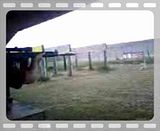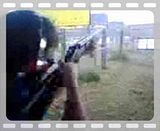Even more than the crazy fireballs you get from Mosin-Nagant rifles? Folks have videos of them posted all over YouTube. Here's a few examples:age_ranger wrote:FYI, the Remington JHP from Walmart puts off quite a muzzle flash and the UltraMax ammo found at Dicks (mostly .223) has the most flash I've ever seen out of a rifle!!!
Lets see that MUZZLE BLAST...................
Moderator: carlson1
-
NcongruNt
- Senior Member
- Posts in topic: 4
- Posts: 2416
- Joined: Sun Feb 25, 2007 12:44 am
- Location: Austin, Texas
-
jimlongley
- Senior Member
- Posts in topic: 3
- Posts: 6134
- Joined: Wed Jan 12, 2005 1:31 pm
- Location: Allen, TX
Not those guns. A 16/50 Mark 7 naval gun, which the Iowa class ships carry, has a muzzle velocity of just under 2700 fps, which could hardly be considered "very high velocity" and had a looping trajectory best described as resembling a short fly ball in baseball.KBCraig wrote:Naval guns are very high velocity, with a flat trajectory.
The AP (capped) 2700 pound projectiles were also designed to be high angle penetrators, so for ship to ship combat elevation angles would normally be high.
The Mark 2 turret, mounting three guns, has a lower limitation to depressing the guns based on the loading mechanism. All of the guns pictured appear to be at that elevation, leading to the assumption that a salute was being fired rather than any combat readiness exercise.
On the other hand, if those Phalanx CIWS Gatlings above the bridge were firing, then the very high velocity, flat trajectory, definitiion would fit, and it would make a pretty impressive mussle blast pic.
Real gun control, carrying 24/7/365
-
jimlongley
- Senior Member
- Posts in topic: 3
- Posts: 6134
- Joined: Wed Jan 12, 2005 1:31 pm
- Location: Allen, TX
I don't know if I can give a definition, but I had the oportunity to serve in both an infantry unit and an armor unit in the Army. In the infantry I was in the mortar section, and we used both 60mm and 81mm mortars. These are clearly high angle weapons. They are also indirect fire weapons.KBCraig wrote:Naval guns are very high velocity, with a flat trajectory.jimlongley wrote:Actually that's what those battlewagon guns appear to be doing, they are depressed too far to achieve much range.
Point of order: can anyone here define the difference between low-angle and high-angle fire?
In the armor unit I was tank crewmember. The M1A1 has a 120mm main gun. This is a direct fie weapon, and I would say it has a low angle of fire.
-
age_ranger
- Senior Member
- Posts in topic: 2
- Posts: 1167
- Joined: Tue Feb 14, 2006 4:11 pm
- Location: Plano, Tx
I think the Ultramax ammo might have more flash, but I never recorded it and have since sold my AR.
http://www.berettaforum.net" onclick="window.open(this.href);return false;
Just remember: Your very best thinking got you where you are now!!!
Just remember: Your very best thinking got you where you are now!!!
Thanks for playing along, I was just jerking your chain.KRM45 wrote:I don't know if I can give a definition, but I had the oportunity to serve in both an infantry unit and an armor unit in the Army. In the infantry I was in the mortar section, and we used both 60mm and 81mm mortars. These are clearly high angle weapons. They are also indirect fire weapons.KBCraig wrote:Naval guns are very high velocity, with a flat trajectory.jimlongley wrote:Actually that's what those battlewagon guns appear to be doing, they are depressed too far to achieve much range.
Point of order: can anyone here define the difference between low-angle and high-angle fire?
In the armor unit I was tank crewmember. The M1A1 has a 120mm main gun. This is a direct fie weapon, and I would say it has a low angle of fire.
Direct fire is sighted directly from the weapon to the target. Tanks are almost always direct fire, but they were sometimes used as indirect fire from WWI through Korea. Perhaps rarely in Vietnam, but we had so few tanks there (and so much artillery), it's unlikely.
High angle and indirect are not the same. Lots of mortars (which are always high angle) are direct fire, because the gunner sights directly on the target.
The question I posed stumped many of us at FAOBC 5-86. Since the question was even asked, it had obviously puzzled many generations of artillery officers.
Here's the official definition: High angle fire is that at which range decreases with an increase in muzzle elevation. Low angle fire is that at which range increases with an increase in muzzle elevation.
That's the official Fort Sill answer.
Thanks for the info. I was going to say something about the mortars having such an array of different charges and elevations that would produce a different trajectory but still hit the same place...
Oh, and we could rarely see our taget... I did get to train some with the 60mm in trigger mode which is kind of neat
Oh, and we could rarely see our taget... I did get to train some with the 60mm in trigger mode which is kind of neat
KBCraig wrote:Thanks for playing along, I was just jerking your chain.KRM45 wrote:I don't know if I can give a definition, but I had the oportunity to serve in both an infantry unit and an armor unit in the Army. In the infantry I was in the mortar section, and we used both 60mm and 81mm mortars. These are clearly high angle weapons. They are also indirect fire weapons.KBCraig wrote:Naval guns are very high velocity, with a flat trajectory.jimlongley wrote:Actually that's what those battlewagon guns appear to be doing, they are depressed too far to achieve much range.
Point of order: can anyone here define the difference between low-angle and high-angle fire?
In the armor unit I was tank crewmember. The M1A1 has a 120mm main gun. This is a direct fie weapon, and I would say it has a low angle of fire.
Direct fire is sighted directly from the weapon to the target. Tanks are almost always direct fire, but they were sometimes used as indirect fire from WWI through Korea. Perhaps rarely in Vietnam, but we had so few tanks there (and so much artillery), it's unlikely.
High angle and indirect are not the same. Lots of mortars (which are always high angle) are direct fire, because the gunner sights directly on the target.
The question I posed stumped many of us at FAOBC 5-86. Since the question was even asked, it had obviously puzzled many generations of artillery officers.
Here's the official definition: High angle fire is that at which range decreases with an increase in muzzle elevation. Low angle fire is that at which range increases with an increase in muzzle elevation.
That's the official Fort Sill answer.
-
stevie_d_64
- Senior Member
- Posts in topic: 7
- Posts: 7590
- Joined: Fri Mar 04, 2005 11:17 pm
- Location: 77504
-
stevie_d_64
- Senior Member
- Posts in topic: 7
- Posts: 7590
- Joined: Fri Mar 04, 2005 11:17 pm
- Location: 77504
Here's a neat video...
Make sure your speakers are turned down a notch or two...
Being on the weatherdeck filming this might have been a neat idea at first...But after the first salvo...nahhhh...
Not that its "that" loud...It kinda moves you around a bit...
Make sure your speakers are turned down a notch or two...
Being on the weatherdeck filming this might have been a neat idea at first...But after the first salvo...nahhhh...
Not that its "that" loud...It kinda moves you around a bit...
"Perseverance and Preparedness triumph over Procrastination and Paranoia every time.” -- Steve
NRA - Life Member
"Quis custodiet ipsos custodes?"
Μολών λαβέ!
NRA - Life Member
"Quis custodiet ipsos custodes?"
Μολών λαβέ!


